Chapter 9: Driving Customer Acquisition and Adoption with a Product-Led Strategy

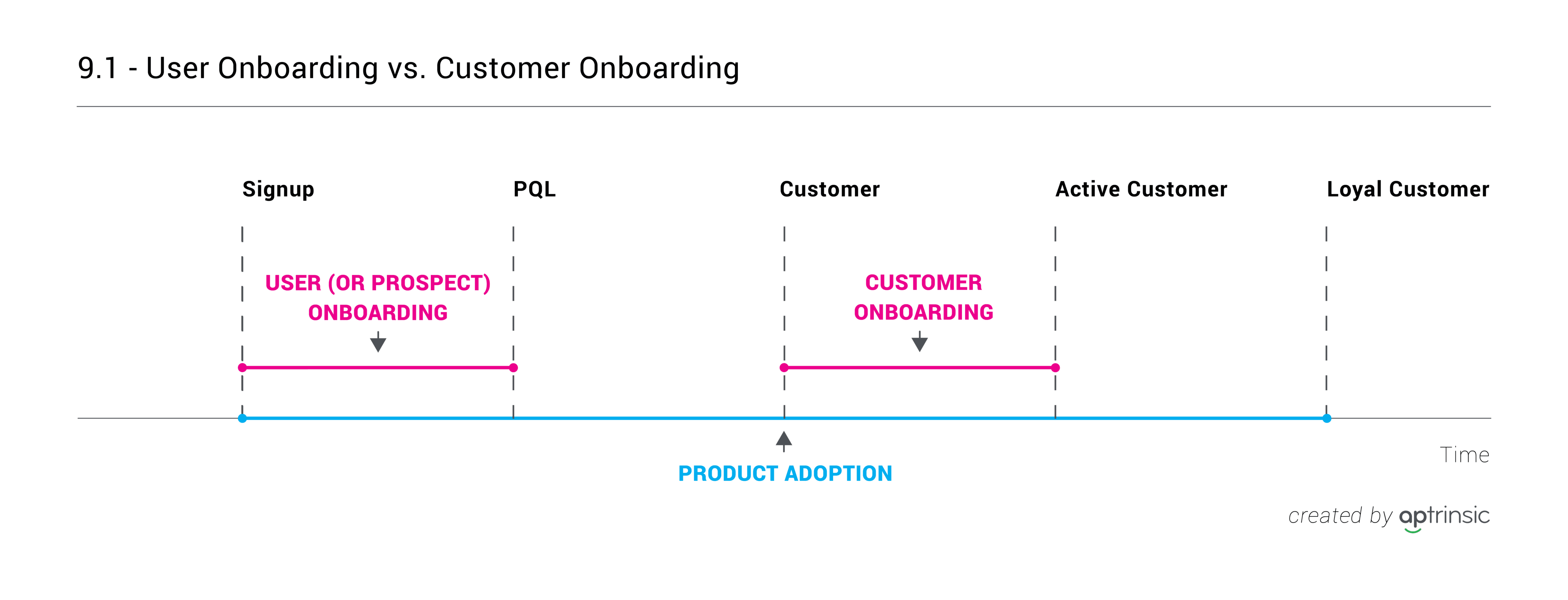
Now let’s explore how a product-led GTM strategy affects the four major phases of the customer lifecycle: acquisition, adoption, retention, and expansion. First, we will explore the initial phases (acquisition and adoption), and then we will dive into the follow-on phases (retention and expansion).
9.1 The Four Steps to Leading with a Product-Led Strategy
What we have covered so far may feel theoretical or daunting, so in this chapter, we are getting down into the nuts and bolts of putting a product-led strategy into place.
Step 1: Drive prospects to try the product
A product-led GTM strategy aligns teams — and more specifically, marketing — to zero in on one call to action (CTA), such as a “Free Trial” or “Signup” for a freemium. This helps everyone — but marketing in particular — focus on getting prospects through one valuable conversion door.
The product-led strategy doesn’t change the goal of marketing to generate demand through a variety of channels, using quality thought leadership content and other means. However, two shifts occur that make marketing teams more efficient and effective at building awareness and acquiring customers.
First, marketing uses a single CTA, where the signup page becomes a personalized landing page, so instead of creating multiple landing pages and lead forms, as was the case in the MQLs era, marketing can use a product signup page as a landing page for testing and optimizing conversions.
Second, a product-led approach provides marketing teams with a new dimension of data: product usage. They can, in turn, use this to develop and offer higher-quality thought leadership content and build marketing campaigns focused on profitable customer segments with a higher potential CLV.
Here is an example of this at work. Let’s take PandaDoc, a company providing a document management solution that helps companies create, send, and track proposals and quotes. Because the company tracks and analyzes a large number of quotes and proposals, it can provide insights into how to improve response time and accuracy. For example, PandaDoc found that shorter proposals, sent earlier in the day, with a deadline attached, are signed faster. In its content, PandaDoc shares insights such as these that it has learned by studying how its product is used. In this way, its product-led approach empowers it to create thought leadership content that helps its prospects and customers learn how to be more effective. In other words, understanding how customers use your product can directly impact your content strategy and marketing campaigns.
A lot of guesswork is eliminated from the process of creating marketing campaigns because teams analyze profitable customer segments through product usage and target those segments.
Step 2: Design your free trial process or freemium offer
The two most popular pricing models in SaaS are freemium and free trials. Let’s finally define freemium and free trial strategies:
Freemium is a customer acquisition model that provides access to part of a software product to prospects free of charge, without a time limit.
Free trial is a customer acquisition model that provides a partial or complete product to prospects free of charge for a limited time. Typically, a free trial runs for 14 or 30 days.
There are pros and cons to both approaches. Some companies don’t support a freemium strategy because it can create additional costs for the organization to serve free customers, but many companies find it effective. Remember: A freemium product does not limit the amount of time a prospect can access the software, but often limits users in some way, such as through stripped-back features or allowed amount of usage. Slack employs a freemium model, and so do Zoom.us, Dropbox, and Asana. Companies such as Atlassian, Github, and Twilio focused on the developer market, and started with freemium.
When deciding whether a free trial or freemium strategy is right for your company and product, we recommend estimating the size of the addressable market. Jason M. Lemkin outlines the math behind making freemium work in his article “Why You Need 50 Million Active Users for Freemium to Actually Work”. Suffice to say, the addressable market should be large enough for you to capture a significant chunk of it and be profitable while only converting 10 percent of free users. The pros and cons of freemium and free trial are highlighted in Table 9.1.
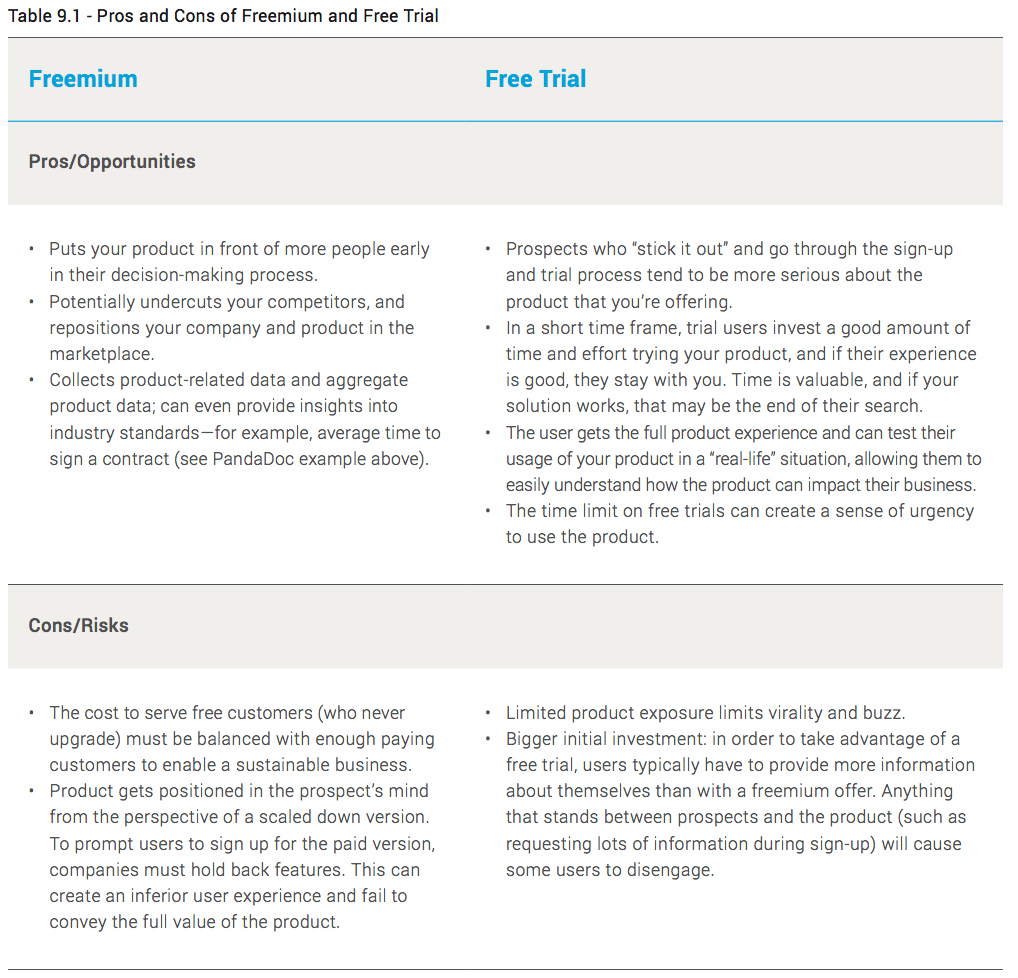
Freemium model considerations
There are many ways to structure a freemium offering, including feature-limited, capacity-limited, seat-limited, customer-class-limited, support-limited, and time- or bandwidth-limited. Lincoln Murphy’s article provides a good overview of seven types of freemium to consider.
Here are questions for your team to ask when considering a freemium model:
- How much will it cost to sustain a large segment of free customers? Is a freemium model scalable for your business?
- Can we provide enough value for users to realize product benefits but still limit value to entice them to pay for a subscription?
- How difficult is it to get started with the product? Does it require technical integration and broader organizational approval?
- How will we nurture and prioritize freemium users that are ready to purchase?
- Are we attracting the right kind of customer (i.e., a customer in our target market with a real need, an urgency to purchase, and a desire to expand the subscription)?
To recap, freemium makes more sense when your organization is facing:
- A large addressable market
- Low costs to serve free users
- Low barriers/commitment for users to start with your product
If your company meets these criteria, freemium may be the way to go. Note: Make sure you articulate how different the user experience is between free and paid versions; prospects need to know what they’re missing. Consider a free trial strategy before making a choice.
Free trial considerations
The goal of the free trial is to deliver as much value as possible to users during their trial period. For the purpose of this discussion, we will concentrate on an ungated free trial strategy, which means a user can sign up and set up a trial without talking to a sales rep. With gated free trials, users request access to the product and get approved by a sales or sales development representative. An ungated free trial is essentially a self-service version of the traditional Proof of Concept (PoC) approach.
Important questions to consider before deciding whether a free trial strategy is right for your organization:
- How long does it take for prospects to realize initial value on average? How long should the trial last?
- What features can and should our team limit or remove from the free trial process?
- How do we nurture a free-trial user? What in-product behavior correlates with an optimal trial-to-customer conversion rate?
A free trial signup process is typically the first time prospects come into contact with your product. An effective trial signup includes a simple, guided journey that is painless and immediate. The critical part of the guided journey is getting prospects to an “A-ha!” moment, when they experience and realize the true value of your product.
Think of a free trial as a chance for users to test drive your product like they would a new car, on their own, seeing how it handles when driven to their favorite or most-visited places. Picture them taking it on a winding back road and pushing it on the freeway. There’s no salesman with these prospects, but the guide makes sure the journey takes them where they need to go to experience the right “A-ha!” moment.
Table 9.2 outlines important considerations for launching a successful free trial process, and shows how it maps to our own software trial process.
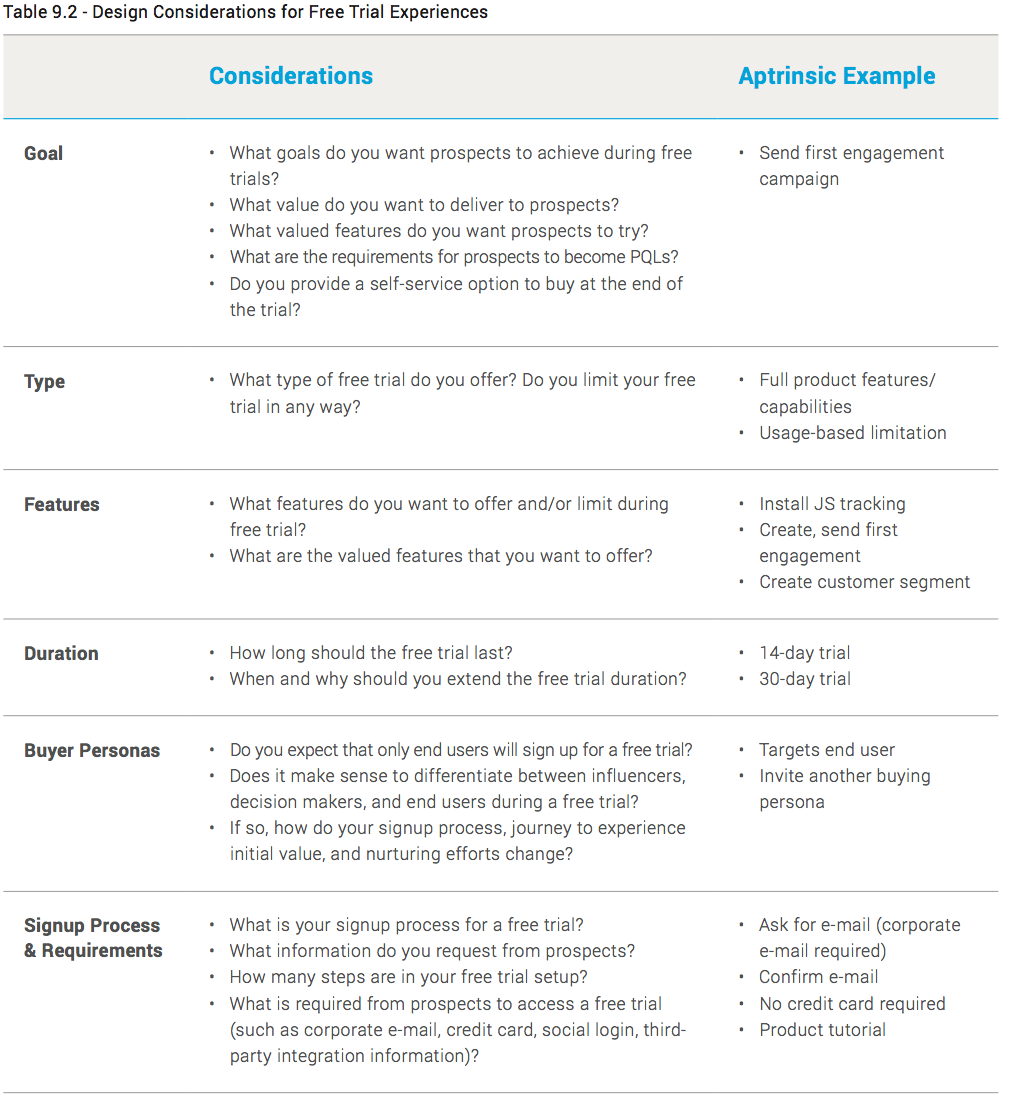
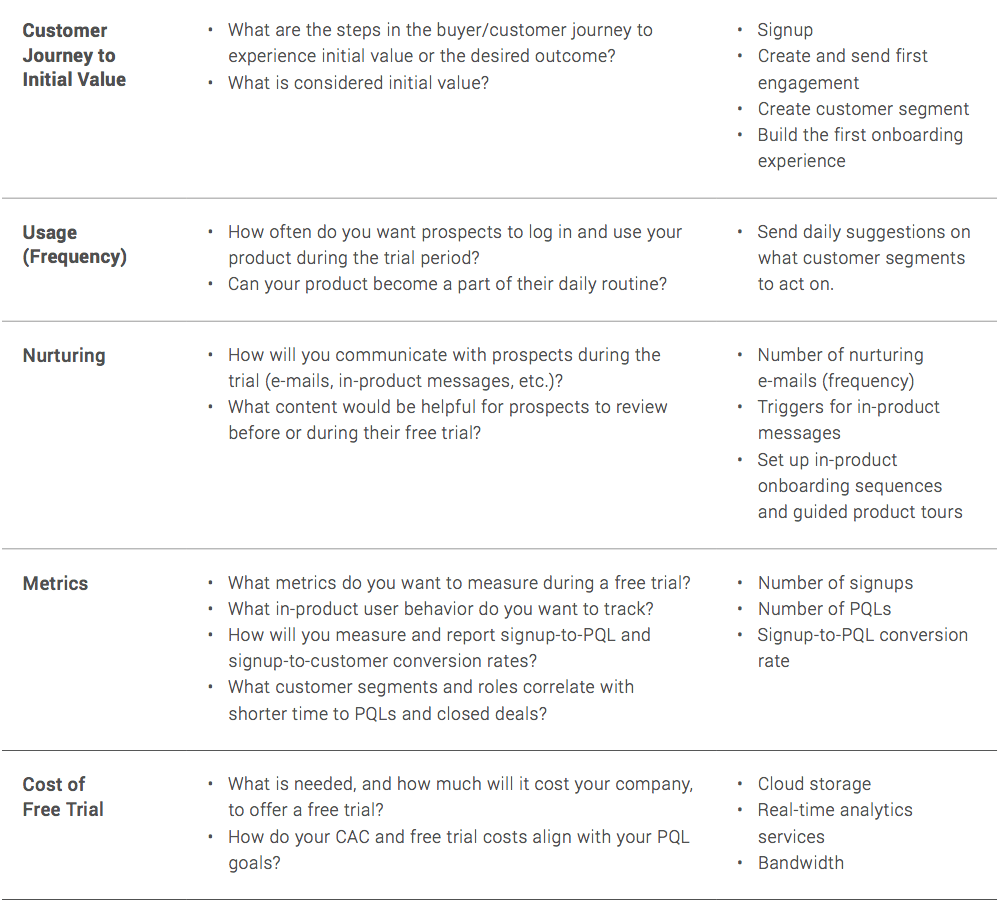
Let’s dig a bit deeper into how a product-led approach enables and impacts these various design considerations.
Personalizing the experience
A product-led GTM strategy empowers product, marketing, sales, and success teams to think of their products as marketing and sales channels. In fact, any part of the free trial experience can be personalized. Not only can the product be personalized, but so can the customer acquisition experience — through the free trial, pricing, messaging, and contextual engagement. Let’s go over some of these in more detail.
Initial signup process considerations
The free trial signup is basically your product signup process, and it’s critical for your teams to spend time thinking about the complexity, clarity, and user experience. Minimizing the amount of information required for prospects to sign up, and reducing the number of steps in the signup process, are easy ways to improve the experience from the start.
Tip: Design a signup process that only highlights one action per step. Avoid asking for personal or contact information that is not essential to get started with your product, unless it increases the value your product can deliver. Also, track the steps in the process so you can pinpoint where prospects fall off and become inactive.
Initial value and customer journey considerations
Prospects who sign up for your free trials should experience initial value (or a desired outcome), ideally in an experience that doesn’t turn them off. Put another way, you want prospects to start using your product with as little friction as possible. That’s means don’t ask about company size, job title, revenue, industry, or credit card information as a signup requirement.
Next, you must enable them to accomplish their goal as easily as possible to reach the initial value. Kintan Brahmbhattt, Director of Product Management at Amazon, describes this as getting them to “perform one meaningful task…that sets expectations for a future engagement.”
To reach initial value, prospects need to go through a core journey that represents a set of actions leading to desired value. In Part 3, we provided a few examples of how some well-known companies track journeys on the way to initial value. Zoom.us, for example, orchestrates a smooth experience for new users to sign up, organize, and hold their first video conferences.
Tip: Design the shortest and most meaningful journey for prospects to experience initial value.
Free trial duration and usage frequency considerations
Regardless of free trial duration, your company doesn’t need to wait until the end of the trial period to try to convert prospects. Trial duration provides urgency for prospects to take action. But whenever a prospect realizes initial value and reaches PQL status, this signals a good time for your sales team to engage in a buying conversation.
The goal of every SaaS product is to become an essential part of the prospect’s daily life and workflow. The more often prospects engage with your product’s core capabilities, the more likely they are to convert. With that in mind, monitor how frequently prospects log in to your product during the free trial. Prospects are more likely to create new habits (such as accomplishing a daily task a certain way) the more frequently they use your product.
Tip: Don’t wait until the end of the trial period to engage with a prospect. Show how your product fits into their daily activities, routine, and workflow.
Free trials and a new wave of growth-hacking
Free trials can support personalized growth strategies, such as extending a free trial if a prospect completes a certain number of actions or invites more team members to participate. One reason to extend a free trial is to engage multiple end-users as well as different buying personas in the organization — to build a team habit that could lead to a higher selling price.
For example, your company can design and test a few different ways of inviting team members, or allowing prospects to extend the trial invitation to people in their extended networks. The incentives could be to increase free trial duration or increase product usage. A few companies in the cloud space, including Dropbox, incentivize with increased storage space, but it could be a much smaller action that incentivizes usage. Perhaps you make it easy for a prospect to send a pre-composed Tweet or other social media share once they’ve successfully onboarded or reached the end of a successful use-case journey. For example, Unroll.me, a service that helps you instantly unsubscribe from unwanted e-mail subscriptions and clean your e-mail inbox, asks users to share about their experience on Twitter and Facebook.
Bottom line: A product-led approach empowers your teams to experiment with growth-hacking strategies designed to increase awareness, virality, signups, and prospect conversions.
Tip: Explore opportunities to extend free trials based on certain prospect behaviors; target to increase account penetration (more peers exposed to the product) and to increase signups from other organizations and individuals.
Product demos during free trials
In a traditional sense, the “Request a Demo” CTA was part of the MQL generation process. The idea was to qualify prospects and show them a targeted and personalized product demo. With a product-led GTM strategy, a product demo can be a supplemental engagement targeted to prospects while they are in free trials.
In-product behavioral data helps your teams understand where and how a prospect is struggling with learning about and using your product. If your organization can create pre-packaged, yet personalized, training sessions addressing the most common roadblocks, you could show these to users during their free trial when relevant.
For more complex software solutions, a free trial can be a trigger to send a prospect an e-mail or in-product message with a product demo offer. This could be a great opportunity for your sales team to engage with prospects in more meaningful ways. In this case, your sales team’s role is to help prospects learn your product, rather than just push the sale. This consultative approach to selling becomes more effective with a product-led strategy, because your sales team can better prepare for product demos based on prospect in-product behavior.
Tip: Offer prospects a free trial, and then a personalized demo, if your product is more complex or requires more effort to set up and onboard.
Measuring free trial success
Measuring the effectiveness of a free trial is necessary for optimization and experimentation purposes. These are common metrics for measuring success:
- Number of trial signups, PQLs, and closed deals
- Average time from signup to PQL (time to initial value)
- Trial-to-PQL conversion rate
- Average engagement based on features and timeframe
- Frequencies of login (daily, times/week)
- Number of prospects per account
We will cover metrics in more detail later in chapter 13.
Tip: Analyze prospects’ behaviors during free trials and identify key triggers that cause them to move along their journeys toward realizing initial value.
Step 3: Create onboarding experiences
Often prospect (or user) onboarding and customer onboarding terms are used interchangeably. However, from the perspective of a product-led GTM strategy, it makes sense to differentiate between prospect and customer onboarding, because these users have different goals and are at different stages of the customer lifecycle.
Prospect (or user) onboarding is how a prospect moves through initial signup, experiences initial value, and reaches PQL status. It is designed to help users become familiar with the product and realize initial value as soon as possible.
Customer onboarding is the process of getting a newly subscribed customer (or account) up and running effectively with your product, which usually includes much guidance and hand-holding. The goal here is to set the customer up to realize the full value of your product, thereby retaining customers while also expanding business within the account, or getting referrals from your happy customers.
There are practical reasons to differentiate user and customer onboarding. Customer onboarding includes in-depth product training, setting up individual users for the account, guiding customers through third-party integrations, setting up payments, and periodic check-ins. This is especially true for more technical products requiring high-touch sales.
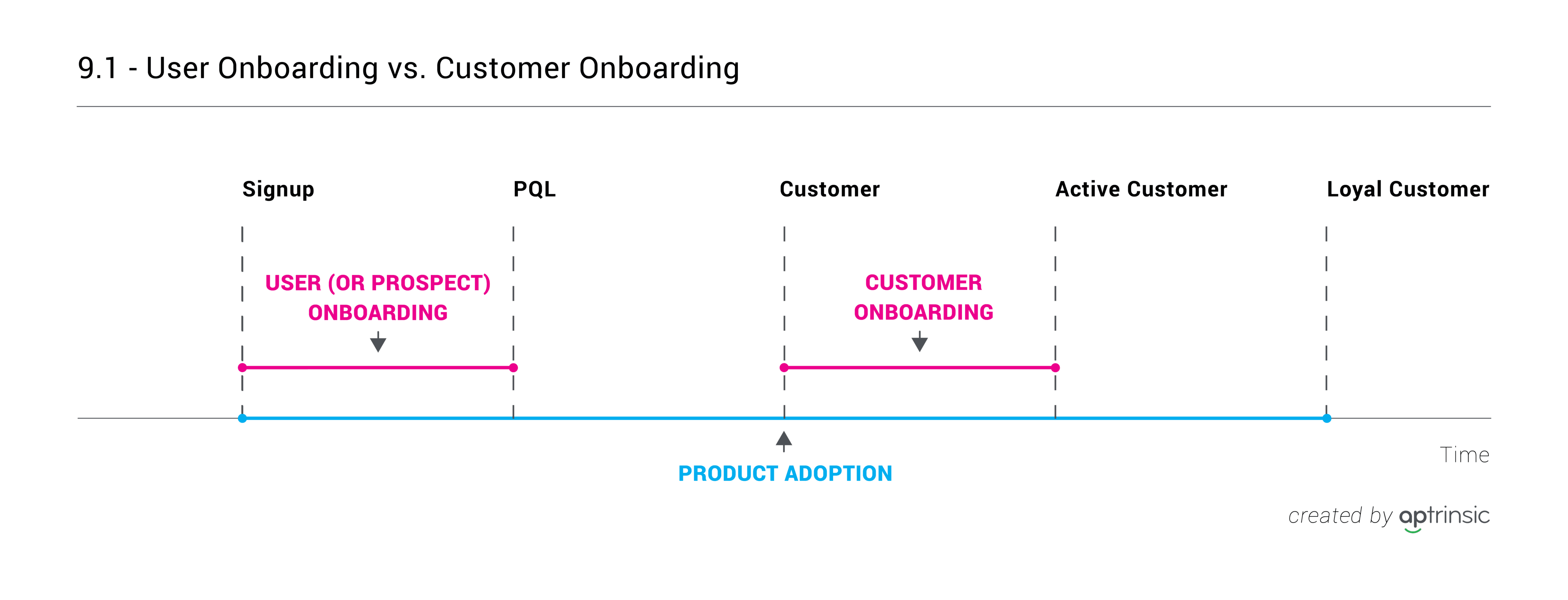
Even though we differentiate prospect and customer onboarding, the onboarding process itself is a continuous process. As soon as a prospect is onboarded and becomes a customer, customer onboarding begins. Assuming you continually introduce new features, customer onboarding doesn’t ever stop, as the process needs to be repeated to encourage the adoption of new product capabilities.
That said, onboarding morphs into the adoption process, and adoption never ends. The onboarding process has specific milestones and goals, while adoption is a continuous process. In this regard, we slightly disagree withIntercom — just as you can’t continuously board a plane, you can’t continuously onboard, because once you have onboarded, you begin the (continuous) process of adoption.
Ideally, a person will onboard twice — first as a user, and then as a customer — but then they move into the adoption process. Just as it’s a never-ending process to hone your skills at something (say, skiing), it’s a never-ending process to adopt and make the best use of a product and new features.
How Aptrinsic onboards prospects
Figure 9.2 outlines how we at Aptrinsic think about onboarding our prospects and customers.
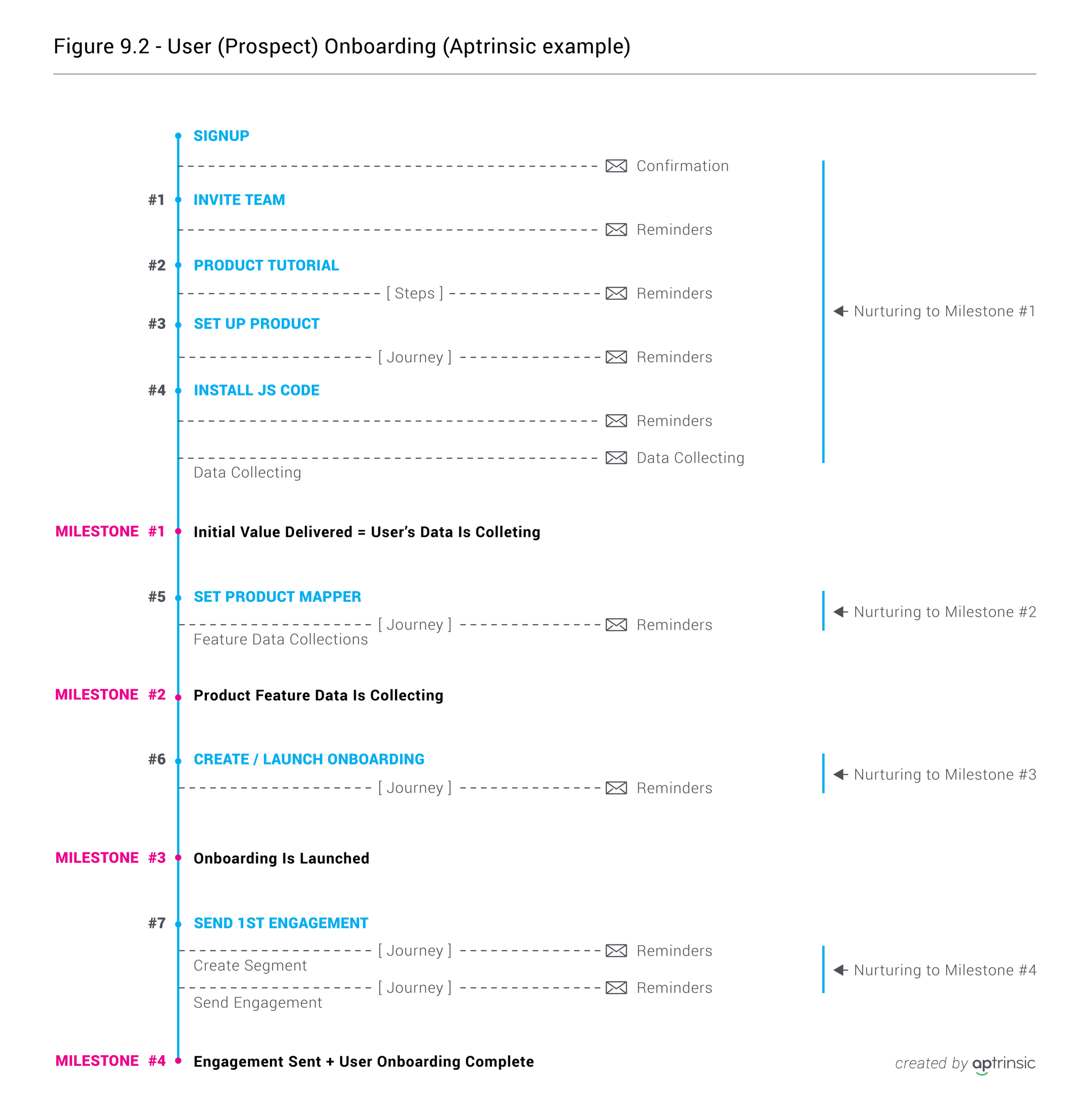
Let’s take a closer look at our onboarding process.
Phase 1: Reaching initial value
Steps 1 through 4, in Figure 9.2, show the customer journey to initial value. Prospects experience initial value when they install our JS code and start collecting user data.
Milestone #1: Install JS code and start collecting data
Note: Each step could contain smaller sub-journeys. For example, Step #3 — Set Up Product — will include multiple interactions.
Phase 2: Setting up Aptrinsic Product Mapper™
In step 5, we outline the journey that a prospect takes to start collecting data on specific product features and interactions.
Milestone #2: Collecting usage data for specific product features + becoming PQL
Phase 3: Designing onboarding experience
In step 6, we guide prospects to create and launch onboarding guides for their users.
Milestone #3: Prospect launches onboarding experience for customers
Phase 4: Sending first campaign
In step 7, prospects are guided to create their first customer segment and first engagement campaign.
Milestone #4: Prospect’s onboarding is completeWe organized our onboarding experience into four phases and defined milestones for each. The order of these phases can change, but for prospects to understand the value of our product, they have to complete all four phases.
Our onboarding process may look similar to others, but a couple of notable distinctions make this a product-led approach. First, we base our nurturing campaigns on in-product behaviors. Second, we clearly define a PQL as a prospect who completes milestones one and two (installed JS and set up our Product Mapper).
As soon as a prospect reaches PQL status, our SDR is notified to follow up with the prospect to offer a personalized demo of the full product.
How to Ensure a Successful Prospect Onboarding Experience
Here are nine things you should always do when onboarding prospects.
1. Define onboarding goals and milestones
To know when a prospect is onboarded, define exactly what it means to be onboarded.
- What set of actions must prospects complete to realize the full value of our product?
Connecting onboarding goals with milestones enables your teams to know where prospects fall off and why. Additionally, every milestone should end with a prospect receiving new value from your product. Hitting a milestone should feel like a completed task. Let’s take a closer look at how we design onboarding goals and milestones at Aptrinsic.
Aptrinsic example:
Goal: Prospect (account) launches first onboarding experience for its customers and sends first engagement campaign.
Milestones:
- Installs JS code
- Invites team
- Completes product tutorial
- Creates product
- Installs JS code
Customer Value: Prospect can see their users’ activity data from product usage. - Sets up Product Mapper
Customer Value: Prospect can now itemize product features. - Launches first onboarding campaign
Customer Value: Prospect can see how new onboarding experiences unfold. - Sends first engagement campaign
- Creates customer segment
- Designs engagement campaign for the segment
Customer Value: Prospect monitors how new engagement brings the user back into the product.
2. Simplify customer journeys
To reach each milestone, a prospect completes a set of actions that resembles a journey. It’s important to simplify these journeys and ensure that nothing distracts prospects from achieving their goal with the product.
Teams can improve the onboarding success by focusing on one action a prospect needs to complete per step. Minimizing the number of options helps prevent decision paralysis and dissatisfaction.
To recap, customer journeys should:
- Include one action per step
- Be limited to 5–7 steps to complete a milestone
- Guide prospects with personal and simple messages
InVision is a great example of a simple onboarding experience. You can sign up on their website for a free trial, and in just five steps, you’re ready to create your first project. Each step in the InVision onboarding journey is focused on a single action. All other distractions are eliminated.
3. Get to initial value quickly
When prospects sign up for a freemium or free trial, they want to address certain pains or needs. It’s best to focus on understanding what constitutes initial value for them, and reducing the time to realize that value.
For example, InVision’s five-step initial signup process doesn’t ask for things that aren’t necessary such as uploading an image for your avatar or connecting to social media sites. These actions don’t help prospects reach their initial value and understanding of the product, so it’s wise not to include them in onboarding.
4. Address “zero data/empty state”
“Zero data” or “empty state” is what prospects see during their initial signup process when no data is available in the product. The way to address this issue is to guide the prospect through a journey that populates, uploads, or integrates data into your product. Benjamin Brandall, in his article “The Most Overlooked Aspect of UX Design Could Be the Most Important”, argues that empty state is a great opportunity for teams to highlight emotional connections with users. Empty state can entice users with one CTA that will help make your app experience more meaningful. You might get inspired by the 40 clever empty state designs for mobile apps shared in this article by Nancy Young.
5. Define a PQL
In the world of marketing automation, lead scoring is the primary method that marketing teams use to monitor how prospects are nurtured and determine the right moment for SDR teams to qualify prospects. With a product-led strategy, a PQL serves this purpose. It is essentially an activated user that has realized initial value within your SaaS product, and is showing enough interest to trigger your sales team to engage with that prospective customer.
While the definition of a PQL remains consistent from company to company, each organization must determine their formula for determining a PQL. For example, at Aptrinsic, a PQL is a prospect that completes Milestone 1 + Milestone 2. The most effective way to determine your formula is to get your marketing, sales, customer success, and product teams together to collaborate on an agreed-upon definition.
Aptrinsic PQL = install JS code (Milestone 1) + set up Product Mapper (Milestone 2)
6. Personalize the onboarding experience with custom journeys
If inviting a prospect’s team members into the trial is part of your onboarding process, you’ve got an amazing opportunity to design and test personalized experiences based on buyer or user roles. For example, at Aptrinsic, we guide end-users to create a segment or campaign. But we believe it is more valuable to guide Chief Product Officers to their dashboard and walk them through each metric.
- Does your prospect or customer onboarding experience change depending on the buyer persona?
Setup wizards, product tours and tutorials, walkthroughs, and tool tips are examples of ways to design personalized onboarding experiences. Their capabilities and functionality vary, but they are intended to help prospects and customers adopt your product.
For example, a progress bar and checklist can show prospects where they are in the product setup process. Many enterprise software products also include a notification center as a central location for all important communications and updates. This enables companies to personalize communication with prospects and guide them to the next onboarding step, all within the product.
7. Nurture with personalized communication
An onboarding experience can take a prospect an hour, a week, or even a few months. That said, personalized communication can accelerate the process. E-mail and in-product messages are two primary channels to re-engage and guide prospects when they abandon onboarding journeys.
Tip: In-product messages are effective for influencing customers to engage in specific ways, because they’re already in the product.
You can configure e-mails to be triggered to send automatically based on a prospect’s action or inaction, reminding them about product value and driving them back into the product with a single CTA.
Other examples of action-based (or time-based) communication triggered by a specific action or inaction include welcome e-mails and notifications that the app started collecting data or that a team member joined the product. Here is an example of a time-based trigger: a prospect leaves without completing the journey to initial value, and within 24 hours receives an e-mail reminder encouraging a return to the product to complete the journey.
In addition, you can call upon transactional communications to nurture prospects. Examples include confirmation e-mails, “reset your password” e-mails, copies of the receipt, and so on.
When using nurture:
- Behavior-based (or action-based) communication works best
- Time-based triggers help engage at the right time and in the right channel
- Transactional and behavior-based communication can be delivered with e-mail or in-product messaging
8. Document important customer journeys
Tutorials, walkthroughs, and tool tips are effective for guiding prospects within the product, but remember to provide clear documentation that breaks down a specific journey or use case to support in-product engagement.
During the onboarding process, prospects may complete a product tour or a walk-through, but over time they will likely forget how to accomplish a task and turn to documentation, which can guide them step by step. Detailed documentation can even assist prospects in evaluating the core values and ease of using your product. Asana provides an example of clear and helpful documentation in its resource center.
9. Measure and track prospects through onboarding
When it comes to tracking the onboarding experience, you must focus on these two aspects:
- Understanding where prospects fall off (abandon the journey)
- Understanding the velocity at which prospects move through milestones
In-depth product analytics enable your teams to understand where prospects leave their journeys, and how best to tune nurturing communications to address these issues. In some cases, product analytics will inform teams about the need to redesign certain steps — or the whole journey — to improve the percentage of successfully onboarded prospects.
For tracking, consider:
- Number of prospects signed up
- Number of prospects that started vs. number who completed journeys and milestones
- How prospects complete each step in the journey
To recap, here are the nine steps:
- Define onboarding goals and milestones
- Simplify customer journeys
- Get to initial value quickly
- Address “zero data/empty state”
- Define a PQL
- Personalize the onboarding experience with custom journeys
- Nurture with personalized communication
- Document important customer journeys
- Measure and track prospects through onboarding
Important Note: The initial signup and prospect onboarding experience is a critical step in moving users through the customer lifecycle — delivering initial value, reaching PQL, and so on. Customer adoption and retention begins as soon as a prospect starts the signup process. Every milestone on the road to reaching onboarding success has to deliver a valuable outcome. The onboarding experience is not something to be overlooked. It’s a critical aspect of making your prospects understand the ins and outs of your product and its value. By carefully and continuously analyzing the onboarding experience, your teams will understand how effective the process is and how to improve it.
Step 4: Reaching PQLs and converting to customers
As prospects progress through the customer lifecycle, you want them to reach two important milestones. First, newly signed prospects should reach PQL status. Second, you want them to quickly convert from PQL to a closed deal.
It’s a mistake to think about this in a vacuum, as it only pertains to your product. When making buying decisions, prospects are often deciding between four options:
- Use your product
- Do it themselves
- Don’t do it all
- Use your competitor’s product
To accelerate the sales process, your teams should find the best way to show how your product provides more or higher-value benefits when compared to the other options. Doing so — and moving prospects through the acquisition stage — means addressing the common reasons why prospects choose not to buy:
- Lacks a clear understanding of your product’s value
- Has the wrong perception of the product’s functionality
- Doesn’t know how to use your product
- Wasn’t onboarded quickly enough or wasn’t re-engaged at the right time
- Doesn’t experience pain often enough to frequently use your product
- Requires features that are not part of your product
- Lacks budget
- Their tech stack doesn’t integrate well with your product
In the list above, the first four reasons can be addressed with a product-led approach to prospect onboarding, because you’ll use your product analytics and customer data to educate prospects about product value and benefits. We outlined earlier how successful onboarding can accelerate the sales process.
Now, let’s look closely at other tactics that teams can use to accelerate their sales cycles.
Prioritize prospects and PQLs based on in-product behaviors
Prospects expect sales teams to be more knowledgeable about them, their needs, and industry practices. Companies can become more agile by prioritizing efforts based on how engaged prospects are with their products. Here are examples of this in action:
- Behavioral data can help sales teams create more relevant calls with prospects.
- A product-led strategy supports a more accurate prediction of which prospect has the highest trial-to-close conversion rate and CLV.
- The longer a company uses a product-led strategy, the more accurate cross-functional teams get at identifying customer segments with a higher probability to renew and upgrade.
Automate self-service checkout for low-touch customer segments
Sometimes, companies assume that interaction with a prospect customer prior to the sale is always a good thing. But in many instances, prospects prefer a better customer experience to complete their buying process without any contact with sales. In fact, studies show that 47 percent of Baby Boomers prefer self-service, while a whopping 64 percent of millennials do too. We anticipate that a larger portion of business buyers will expect self-service options going forward.
If your product has a broad addressable market, you can capitalize on this trend — and stop wasting valuable sales resources — by offering self-service checkout for a low-touch customer segment can accelerate prospect conversion. Instead of investing in sales resources to convert prospects with a low average selling price (ASP), you can guide low-touch prospects to self-service journeys.
Automate just-in-time personalized engagements
Action-based and time-based engagements can automate some qualification steps that were traditionally part of an SDR process. For example, you cancreate in-product messages and communications as well as emails to influence prospects to get back into the product and move toward a PQL conversion. This frees SDRs to focus on helping prospects and customers with more personalized services, such as custom product demos.
Organize your teams to target the best accounts
In a traditional GTM approach, marketing and sales build custom campaigns targeting specific accounts based on potential ASP and CLV. With a product-led approach, cross-functional teams identify profitable customer segments among prospects in free trials, and design campaigns to target these accounts through social media and advertising channels. Retargeting meaningful personas in the accounts that are in the free trial process enables more efficient spending and higher ROI.
Vision is important for business buyers. That’s why successful companies find a way to communicate product road maps at the closing stage of the buying process. In many cases, a vision will help your team close a deal.
Deliver thought leadership content at every stage of the customer lifecycle
In order to accelerate the sales cycle, cross-functional teams need to understand all personas involved in the buying process. Each persona has a different concern, objection, and perception. One way to engage various personas is with thought leadership content that addresses their individual priorities as well as team-based needs around common concerns and goals.
Traditionally, thought leadership content is delivered at the very top of the funnel, to boost awareness. We understand that thought leadership content is usually reserved for exploring issues and trends and provoking potential customers to consider a new perspective. That said, we believe thought leadership can — and should — be used to characterize content quality rather than content type (or the stage at which it should be used).
We agree that certain content will never qualify as thought leadership; but there’s no reason companies can’t present webinars and guides that teach late-stage customers new and more effective workflows, strategies, or tactics. A product-led strategy makes it easier to deliver this type of content because it provides direct insight how users behave in the product. By drawing upon these insights, organizations can offer quality educational content to assist prospects and customers at every stage of the lifecycle. Whether or not you refer to this as thought leadership, the outcome is the same: deliver value that sets the organization apart and helps drive more revenues.
Remember: with a product-led GTM strategy, your product becomes the primary driver of customer acquisition, retention, and growth. That means you must invest more time and money creating content that helps users learn the product, including product documentation, how-to guides, industry benchmarks, and so on. Content plays an active role in getting people to use your product, so keeping your documentation in good shape is as important as publishing engaging articles to engage new prospects.
Create targeted product demos for trial/freemium customers
In the MQL era, the “request a demo” CTA was used to generate leads and enable sales teams to show the product to a prospect for the first time. With a product-led strategy, you can drive prospects to PQLs, or conversion events to prospects already familiar with your product enables teams to accelerate the sales cycles by testing buying intent. Specifically, your company can design in-product CTAs and offer guided product demos that reveal prospects’ buying intentions and even trigger movement through the lifecycle drive. For example, let’s say your prospect realizes initial value via a free trial, but has not reached PQL status. Your team can offer a sales-guided product demo with an in-product CTA. If the prospect responds to the CTA, you can accelerate their conversion to a PQL.
All the strategies described above in Step 4 impact at least one of the following goals:
- Reduce the time it takes from trial to PQL and from PQL to close
- Increase the Trial-to-PQL rate and PQL-to-Customer rate
- Increase average CLV by focusing on the right accounts
Simply put, a product-led GTM strategy enables cross-functional teams to increase the velocity from the time prospects become familiar with the company and product to the time they buy. In addition, it can potentially increase revenues by letting sales and marketing focus on profitable customer segments and activities.
9.2 Key Takeaways
- Convince prospects to try the product with a single CTA, such as a product signup page.
- Understand the advantages and disadvantages to freemiums and free trials, and choose the one that works best for your company:
- Freemium is best with a large addressable market, low costs of serving free users, and low barriers to start
- Free trial is best if it can deliver or highlight as much product value as possible in a limited time - Any part of a free trial can be personalized, including initial signup, initial value, and customer journey considerations, such as trial duration and usage frequency.
- Shorten the time it takes prospects to reach the PQL stage by:
- Prioritizing in-product behaviors based on their value to you and your customers
- Automating self-service checkout
- Initiating just-in-time personalized engagements
- Prioritizing target accounts with a higher potential to close
- Delivering thought leadership at every stage of the customer lifecycle
- Using targeted product demos
